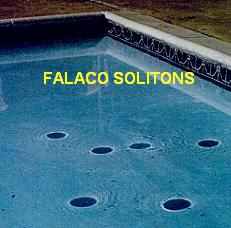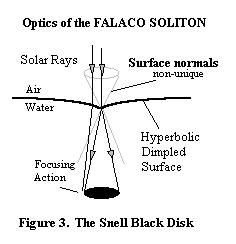|
Falaco Solitons are exhibitions of topological defects in a discontinuity
surface.
Scroll down for The Optics of the Falaco Effect
Falaco Solitons are long lived topological defects in the discontinuity free surface of water. They have remarkably long life times and will persist for 15 to 30 minutes. The black disks are created from the Snell refraction of a surface of rotational symmetry with negative Gauss curvature see Kiehn 1992.
The surface distortion is a pair of dimple-like depressions of a few
millimeters. Unseen to the eye is a one dimensional defect or string that
appears to connect the pair of surface two dimensional defects at their
vertices. The stable shape of the connecting string is in the form of a
circular arc.
The 1-dimensional defect, or string, is made visible by injecting dye drops near
a dimple vertex. The dye drop executes helical transverse wave motion about the
thread which acts as a guiding center. The dynamics is remindful of the action
of whistler waves of charged particles executing helical motion along the
earth's magnetic field line. The drop goes down, then back up, a number of
times until finally the transverse helical motion sweeps out the entire circular
arc connecting the two vertices.
If the string is dynamically severed, like the confinement problem for hadrons,
the two surface defects (or Quarks!) cannot be separated. They disappear with a
non-diffusive pop! Download from LANL archive
|

